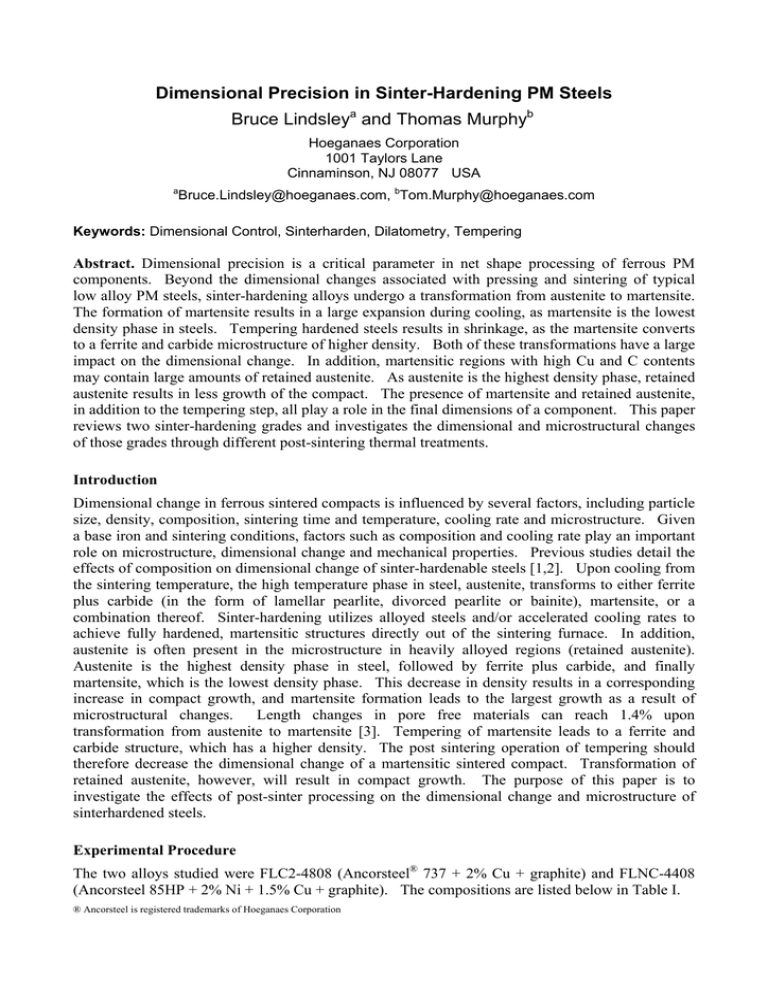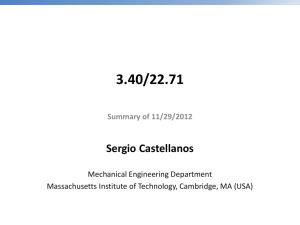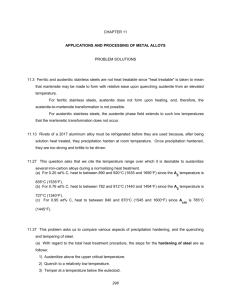Dimensional Precision in Sinter-Hardening PM Steels Bruce Lindsley and Thomas Murphy
advertisement

Dimensional Precision in Sinter-Hardening PM Steels Bruce Lindsleya and Thomas Murphyb Hoeganaes Corporation 1001 Taylors Lane Cinnaminson, NJ 08077 USA a Bruce.Lindsley@hoeganaes.com, bTom.Murphy@hoeganaes.com Keywords: Dimensional Control, Sinterharden, Dilatometry, Tempering Abstract. Dimensional precision is a critical parameter in net shape processing of ferrous PM components. Beyond the dimensional changes associated with pressing and sintering of typical low alloy PM steels, sinter-hardening alloys undergo a transformation from austenite to martensite. The formation of martensite results in a large expansion during cooling, as martensite is the lowest density phase in steels. Tempering hardened steels results in shrinkage, as the martensite converts to a ferrite and carbide microstructure of higher density. Both of these transformations have a large impact on the dimensional change. In addition, martensitic regions with high Cu and C contents may contain large amounts of retained austenite. As austenite is the highest density phase, retained austenite results in less growth of the compact. The presence of martensite and retained austenite, in addition to the tempering step, all play a role in the final dimensions of a component. This paper reviews two sinter-hardening grades and investigates the dimensional and microstructural changes of those grades through different post-sintering thermal treatments. Introduction Dimensional change in ferrous sintered compacts is influenced by several factors, including particle size, density, composition, sintering time and temperature, cooling rate and microstructure. Given a base iron and sintering conditions, factors such as composition and cooling rate play an important role on microstructure, dimensional change and mechanical properties. Previous studies detail the effects of composition on dimensional change of sinter-hardenable steels [1,2]. Upon cooling from the sintering temperature, the high temperature phase in steel, austenite, transforms to either ferrite plus carbide (in the form of lamellar pearlite, divorced pearlite or bainite), martensite, or a combination thereof. Sinter-hardening utilizes alloyed steels and/or accelerated cooling rates to achieve fully hardened, martensitic structures directly out of the sintering furnace. In addition, austenite is often present in the microstructure in heavily alloyed regions (retained austenite). Austenite is the highest density phase in steel, followed by ferrite plus carbide, and finally martensite, which is the lowest density phase. This decrease in density results in a corresponding increase in compact growth, and martensite formation leads to the largest growth as a result of microstructural changes. Length changes in pore free materials can reach 1.4% upon transformation from austenite to martensite [3]. Tempering of martensite leads to a ferrite and carbide structure, which has a higher density. The post sintering operation of tempering should therefore decrease the dimensional change of a martensitic sintered compact. Transformation of retained austenite, however, will result in compact growth. The purpose of this paper is to investigate the effects of post-sinter processing on the dimensional change and microstructure of sinterhardened steels. Experimental Procedure The two alloys studied were FLC2-4808 (Ancorsteel® 737 + 2% Cu + graphite) and FLNC-4408 (Ancorsteel 85HP + 2% Ni + 1.5% Cu + graphite). The compositions are listed below in Table I. ® Ancorsteel is registered trademarks of Hoeganaes Corporation Table I. Nominal compositions (in wt.%) of the alloys studied, balance Fe. Alloy # Designation Ni Mo Mn Cu C 1 FLC2-4808 1.4* 1.2* 0.4* 2 0.8 2 FLNC-4408 2.0 0.8* 0.1* 1.5 0.8 *prealloyed The mixes were compacted into standard TRS and dilatometry test specimens at a compaction pressure of 690 MPa. The samples were sintered in a 90% nitrogen – 10% hydrogen atmosphere at 1120 °C for 15 minutes at temperature. Accelerated cooling was used to achieve a cooling rate of 1.6 °C/sec. Tempering was carried out in a nitrogen purged furnace at 205 °C for the majority of test conditions. After sintering, samples were subjected to a variety of tempering (T) and liquid nitrogen quench (LNQ) operations: 1. as-sintered, 2. LNQ, 3. T/1hr, 4. LNQ + T/1hr, 5. T/1hr + T/1hr, 6. T/1hr + LNQ, 7. T/1hr + T/1hr + LNQ, 8. T/4hr, 9. T at 225 °C/1hr. Dimensional change (DC) from die size and microstructure were evaluated for all nine conditions. Results The as-sintered microstructure of the alloys is predominately martensitic with retained austenite (Figure 1). Figure 1a shows a typical martensitic microstructure, whereas Figure 1b shows the same field etched to reveal retained austenite. The majority of the retained austenite is directly associated with copper rich regions. The dimensional change of these structures will be dominated by the tempering of martensite and the transformation of retained austenite. (b) as (a), then Na2S2O5 in Water (a) 2% Nital / 4% Picral Figure 1. Microstructure of the sinter-hardened Alloy 1 (FLC2-4808) at 1.6 °C/sec etched to reveal (a) martensite and (b) retained austenite (white) in Cu-rich regions (same field). The early stages of tempering involve 3 phenomena: 1) rapid stress-relieve and diffusion of C to dislocations at relatively low temperature, 2) transformation of retained austenite to bainite, and 3) further C diffusion out of the martensite associated with the formation of carbides above 200 °C [3]. The first and third phenomena involve a reduction in length, as the body center tetragonal (bct) structure of martensite changes to bcc ferrite and carbide. The second produces a length increase, as the high density austenite phase transforms to the lower density bainite. To demonstrate these three stages of tempering, dilatometry was run on sinter-hardened Alloy 1. Figure 2 shows the change in length with temperature and it can be seen that the slope of line upon heating is not constant. Between 125 and 175 °C, the slope is greatly reduced as a result of the first stage of tempering. This is a rapid change and does not require a long time at temperature, as it occurs during heating prior to reaching the final temperature. At the 1 hour hold temperature of 205 °C, a small amount of growth can be seen (see inset box) due to retained austenite transformation. Upon cooling, the reduction in sample length is observed (-0.09%). To better illustrate the tempering effects at temperature, two samples were heated to 225 °C to accelerate the dimensional changes. The first sample was quenched in liquid nitrogen prior to tempering to transform the retained austenite to martensite and a significant length decrease (-0.14%) is observed as the sample is heated and held at temperature (Figure 3). This length decrease during the hold is a result of the third stage of tempering. The sample that was not quenched in liquid nitrogen shows growth during the hold as a result of the transformation of retained austenite to bainite. The growth observed is a combination of shrinkage as the martensite is tempered and a larger positive growth as the retained austenite is transformed. Overall, the sample length decreased by only -0.07%. By understanding these phenomena, the effects of post sintering treatments on dimensional change and stability can be better understood in PM parts. 125 Heating 75 Cooling Dilation ( µ m ) 100 50 25 0 -25 -50 -75 0 50 100 150o Temperature ( C ) 200 250 Figure 2. Tempering of Alloy 1 (FLC2-4808) in the dilatometer at 205 °C for 1 hour. 125 125 75 100 Heating 75 Cooling Dilation ( µ m ) Heating Cooling Dilation ( µ m ) 100 50 25 0 50 25 0 -25 -25 -50 -50 -75 -75 0 50 100 150o Temperature ( C ) 200 250 0 50 100 150o Temperature ( C ) 200 a b Figure 3. Tempering of Alloy 1 at 225 °C a) after a liquid nitrogen quench and b) as-sintered. 250 The dimensional change of Alloys 1 & 2 for the various thermal treatments is given in Table II. The results have been normalized to an as-sintered dimensional change of zero. Both alloys have significant levels of retained austenite, resulting in significant growth (+0.13%) with the LNQ quench. Tempering of the martensite results in shrinkage, as the bct structure of martensite converts to a bcc ferrite and carbide structure. Shrinkage results are seen in Table II, where the pre and post temper condition of the as-sintered and LNQ samples are compared. More shrinkage occurs during tempering of the LNQ sample, as there is no growth contribution from conversion of retained austenite. It is interesting to note that the growth of both alloys upon LNQ was the same, but the shrinkage during tempering is consistently lower for Alloy 2. The double tempered sample and the sample tempered for 4 hours show growth relative to the single tempered sample as the retained austenite transforms to bainite. The growth of samples that undergo LNQ is greatly reduced if they have been tempered previously, conditions 6 & 7. This is consistent with a portion of the retained austenite transforming during the temper, and thereby less is present to transform to martensite during the LNQ. The T + T + LNQ has the same DC as T + LNQ. Given that the T + T operation had more growth relative to the T operation and thereby less retained austenite after tempering, it is expected that the T + T + LNQ will have more bainite and less martensite than the T + LNQ. The 225 °C temper for 1 hour resulted in both tempering of the martensite and transformation of the austenite, and is expected to be the most dimensionally stable sample of the single step operations. All of the results are consistent with the tempering stages developed for wrought alloys. Finally, the tempering difference between the two alloys is likely a result of the admixed Ni in Alloy 2. The retained austenite and martensite in the Ni rich regions is expected to behave differently from the rest of the microstructure. Table II. Dimensional change (%) of post sinter operations normalized to the as-sintered length Alloy # 1. AsSinter 2. LNQ 3. T 4. LNQ +T 5. T + T 6. T + LNQ 7. T + T + LNQ 8. T/4hr 9. T/ 225°C 1 0 +0.13 -0.10 +0.01 -0.08 -0.05 -0.05 -0.07 -0.06 2 0 +0.13 -0.06 +0.04 -0.04 +0.01 +0.01 -0.03 - Summary The dimensional and microstructural changes of different sinter-hardening grades were investigated with different post-sintering thermal treatments. Tempering of martensite reduces the growth associated with its formation and produces a less brittle structure. It also improves the dimensional stability of the material. The presence of retained austenite in high carbon alloys can lead to dimensional instability of a PM component. If cooled to low temperature, the austenite will transform to untempered martensite and result in large growth. If heated to a high enough tempering temperature, the austenite will transform to bainite. The most dimensionally stable structure will contain little to no retained austenite and well tempered martensite. References [1] B. Lindsley, G. Fillari, and T. Murphy, PM2TEC2005, Compiled by C. Ruas and T. Tomlin, MPIF, Princeton NJ, 2005 p. 10-353. [2] B. Lindsley and T. Murphy, “Dimensional Control in Cu Containing Ferrous PM Alloys”, PowderMet2006, Compiled by B. Gasbarre and J. von Arx, MPIF, Princeton NJ, 2006. [3] R. E. Reed-Hill, Physical Metallurgy Principles – 2nd Edition, PWS-Kent Publishing, Boston, MA, 1973, p. 701-748.







